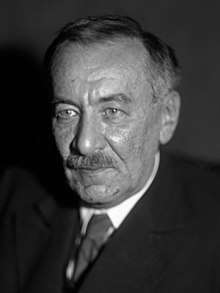Leonid Mandelstam
| Leonid Mandelshtam | |
|---|---|
 | |
| Born |
4 May 1879 Mogilev, Russian Empire |
| Died |
27 November 1944 (aged 65) Moscow, USSR |
| Doctoral advisor | Karl Ferdinand Braun |
| Doctoral students |
Aleksandr Andronov, Mikhail Leontovich, Sergey Rytov, Igor Tamm |
Leonid Isaakovich Mandelstam or Mandelshtam (Belarusian: Леанід Ісаакавіч Мандэльштам, Russian: Леонид Исаакович Мандельштам; IPA: [lʲɪɐˈnʲid isɐˈäkəvʲitɕ məndʲɪlʲˈʂtam]; 4 May 1879 – 27 November 1944) was a Soviet physicist of Belarusian-Jewish background.
Life
Leonid Mandelstam was born in Mogilev, Russian Empire (now Belarus). He studied at the Novorossiya University in Odessa, but was expelled in 1899 due to political activities, and continued his studies at the University of Strasbourg. He remained in Strasbourg until 1914, and returned with the beginning of World War I. He was awarded the Stalin Prize in 1942. Mandelstam died in Moscow, USSR (now Russia).[1]
Scientific achievements
The main emphasis of his work was broadly considered theory of oscillations, which included optics and quantum mechanics. He was a co-discoverer of inelastic combinatorial scattering of light used now in Raman spectroscopy (see below). This paradigm-altering discovery (together with G. S. Landsberg) had occurred at the Moscow State University just one week earlier than a parallel discovery of the same phenomena by C. V. Raman and K. S. Krishnan. In Russian literature it is called "combinatorial scattering of light" (from combination of frequencies of photons and molecular vibrations) but in English it is named after Raman.
Discovery of the combinatorial scattering of light
In 1918, Mandelstam theoretically predicted the fine structure splitting in Rayleigh scattering due to light scattering on thermal acoustic waves. Beginning from 1926, L.I. Mandelstam and G.S. Landsberg initiated experimental studies on vibrational scattering of light in crystals at the Moscow State University. As a result of this research, Landsberg and Mandelstam discovered the effect of the combinatorial scattering of light on 21 February 1928. They presented this fundamental discovery for the first time at a colloquium on 27 April 1928. They published brief reports about this discovery (experimental results with theoretical explanation) in Russian[2] and in German[3] and then published a comprehensive paper in Zeitschrift fur Physik.[4]
In the same year of 1928, two Indian scientists C.V. Raman and K.S. Krishnan were looking for "Compton component" of scattered light in liquids and vapors. They found the same combinatorial scattering of light. Raman stated that "The line spectrum of the new radiation was first seen on 28 February 1928."[5] Thus, combinatorial scattering of light was discovered by Mandelstam and Landsberg a week earlier than by Raman and Krishnan. However, the phenomenon became known as Raman effect.
Scientific school and legacy
Mandelstam founded one of the two major schools of theoretical physics in the Soviet Union (another being due to Lev D. Landau). In particular, he was mentor to Igor Y. Tamm, a Nobel Prize Laureate in Physics.
A crater on the far side of the Moon is named after Mandelshtam.
Selected publications
- L. I. Mandelshtam, I. E. Tamm "The uncertainty relation between energy and time in nonrelativistic quantum mechanics", Izv. Akad. Nauk SSSR (ser. fiz.) 9, 122–128 (1945). English translation: J. Phys. (USSR) 9, 249–254 (1945).
References
- ↑ E.L. Feinberg (2002). "The forefather". Physics-Uspekhi. 45 (1). Bibcode:2002PhyU...45...81F. doi:10.1070/PU2002v045n01ABEH001126.
- ↑ G.S. Landsherg, L.I. Mandelstam, "New phenomenon in scattering of light (preliminary report)", Journal of the Russian Physico-Chemical Society, Physics Section 60, 335 (1928).
- ↑ G. Landsberg, L.Mandelstam (1928). "Eine neue Erscheinung bei der Lichtzerstreuung in Krystallen". Die Naturwissenschaften. 16 (28): 557. Bibcode:1928NW.....16..557.. doi:10.1007/BF01506807.
- ↑ G.S. Landsherg and L.I. Mandelstam (1928). "Über die Lichtzerstreuung in Kristallen". Zeitschrift für Physik. 50 (11–12): 769. Bibcode:1928ZPhy...50..769L. doi:10.1007/BF01339412.
- ↑ C.V. Raman (1928). "A new radiation" (PDF). Ind. J. Phys. 2: 387.
External links
| Wikimedia Commons has media related to Leonid Mandelstam. |
- Leonid Mandelstam at the Mathematics Genealogy Project
- Y.L. Alpert, Tribute to the Scientific School of L.I. Mandelshtam
- Sergei I. Vavilov, Obituary to academician L.I. Mandelstam, 1945